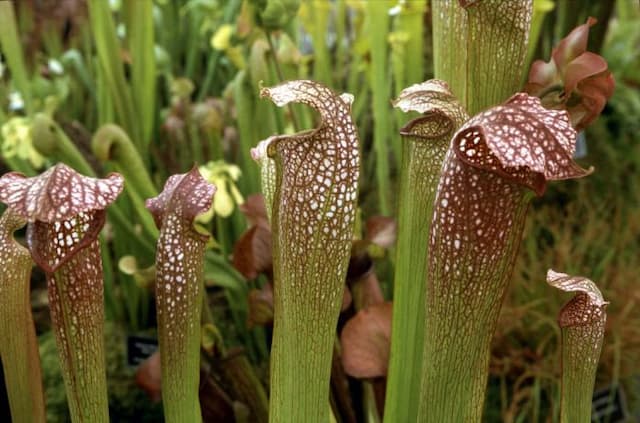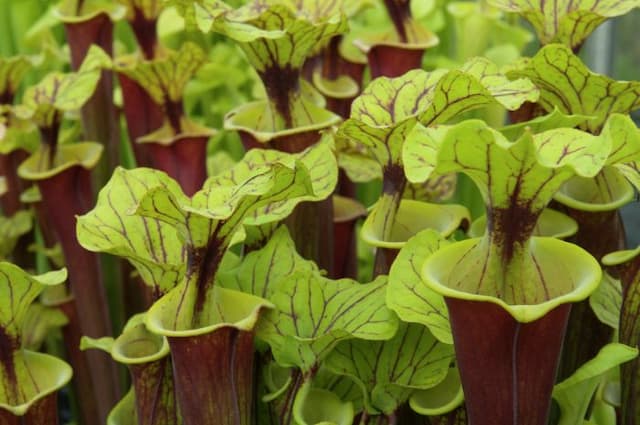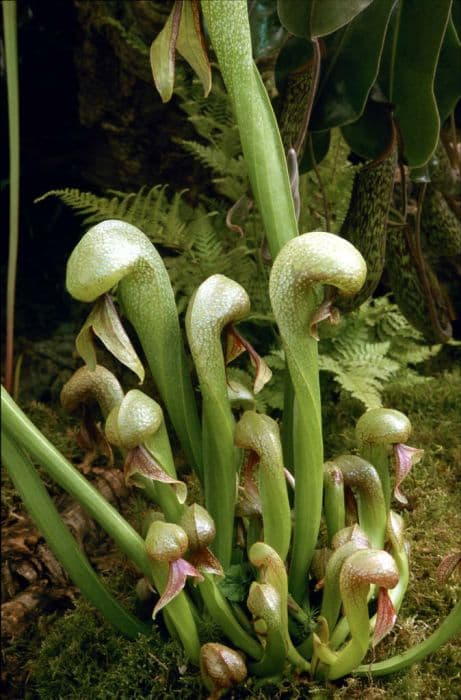Yellow pitcher plant Sarracenia flava

ABOUT
The Yellow Pitcher Plant, commonly referred to by its name Sarracenia flava, is a perennial, carnivorous plant known for its unique and striking appearance. This plant consists of tube-shaped leaves that are modified into what are called pitchers, where the plant traps and digests insects for nutrients. The pitchers are tall and slender, reminiscent of elongated cones, with a flared lip called the peristome which often has a contrasting, wavy edge that can appear ruffled. These pitchers are primarily green, but they can exhibit various colors ranging from yellows to deep reds and purples, depending on the particular variety and environmental factors. The surface inside the pitcher is slick, causing prey to fall into the trap. At the bottom, digestive fluids break down the captured insects. Above the pitchers, the plant produces large, nodding flowers in the spring, which are known for their attractive and unusual look. The flowers have a sweet scent and can range in color, often a vivid yellow with a dramatic, umbrella-like shape that hangs downwards, concealing the reproductive parts. Covering the entrance of the pitcher is a leaf structure that arches over it, often called a hood or operculum, which helps to prevent rainwater from diluting the digestive fluids inside the pitcher. The hood is speckled with translucent areoles or windows, which can confuse prey into attempting escape through them, causing the insects to tire and fall into the trap below. The overall appearance of the Yellow Pitcher Plant is striking and exotic, and it is often sought after as a curiosity and natural insect control for gardens within its growing range.
About this plant
 Names
NamesSynonyms
Yellow Pitcher Plant, Trumpets, Yellow Trumpet.
Common names
Sarracenia flava var. maxima, Sarracenia flava var. ornata, Sarracenia flava var. rubricorpora, Sarracenia flava var. rugelii
 Toxicity
ToxicityTo humans
Yellow pitcher plant (Sarracenia flava) is not considered highly toxic to humans, but consuming parts of the plant, especially in large amounts, could potentially cause stomach upset and digestive issues due to the plant's enzymes and other compounds used to digest insects. It's not commonly ingested by humans, so there's limited information on its effects. If ingested, it would be prudent to monitor for gastrointestinal discomfort and seek medical advice if symptoms arise.
To pets
Yellow pitcher plant (Sarracenia flava) is not commonly known to be poisonous to pets, but as with humans, it might cause mild gastrointestinal upset if ingested. The plant's digestive enzymes could irritate a pet's mouth or stomach, potentially leading to symptoms like drooling, vomiting, or diarrhea. Care should be taken to prevent pets from ingesting this plant, and if they do, monitoring for symptoms and consulting a veterinarian would be advisable.
 Characteristics
CharacteristicsLife cycle
Perennials
Foliage type
Evergreen
Color of leaves
Varies
Flower color
Yellow
Height
1-3 feet (0.3-0.9 meters)
Spread
1-2 feet (0.3-0.6 meters)
Plant type
Herb
Hardiness zones
6
Native area
Southeastern United States
Benefits
 General Benefits
General Benefits- Ecosystem Role: Sarracenia flava, commonly known as Yellow Pitcher Plant, provides a unique microhabitat for various insects and small organisms, some of which have co-evolved to live exclusively in pitcher plant environments.
- Botanical Research Interest: It is an interesting subject for botanical studies due to its carnivorous nature, contributing to a better understanding of plant evolution and adaptation strategies.
- Educational Value: This plant serves as an educational tool for teaching concepts of botany, ecology, and coevolution, particularly the adaptations of carnivorous plants to nutrient-poor environments.
- Horticultural Appeal: With its striking appearance and unusual insect-trapping mechanism, Sarracenia flava is a popular choice among gardeners and collectors of exotic or carnivorous plants.
- Wildlife Sustenance: While it traps and digests insects, it also sometimes supports certain species of insects that have adapted to escape digestion, which can be a part of the local food web.
 Medical Properties
Medical PropertiesThis plant is not used for medical purposes.
 Air-purifying Qualities
Air-purifying QualitiesThis plant is not specifically known for air purifying qualities.
 Other Uses
Other Uses- Sarracenia flava, commonly known as the Yellow Pitcher Plant, can be used as a muse for artists and photographers, given its unique and visually striking appearance.
- In educational settings, the Yellow Pitcher Plant is used to demonstrate carnivorous plant behavior and adaptations in biology and botany lessons.
- This plant can be used as a natural barrier in gardens to protect certain areas from pests, thanks to its insect-trapping capabilities.
- Hobbyists and plant breeders use Sarracenia flava in hybridization to create ornamental plants with new colors and shapes.
- Sarracenia flava's distinctive shape can inspire design elements in fashion, such as prints or patterns in textile design.
- The plant serves as a conversation starter in eco-friendly and sustainable living spaces, exemplifying a self-sustaining system.
- Local cultures may use the plant in storytelling or mythology to illustrate moral lessons or natural phenomena.
- The pitchers of Sarracenia flava can be a temporary container for small, light objects outdoors, as a novel natural organizer.
- Dried or pressed specimens of the Yellow Pitcher Plant are sometimes used in botanical art or herbarium collections to preserve the biodiversity of an area.
- Landscape architects may use Sarracenia flava in water features or bog garden designs to add an element of interest and intrigue.
Interesting Facts
 Feng Shui
Feng ShuiThe Yellow Pitcher Plant is not used in Feng Shui practice.
 Zodiac Sign Compitability
Zodiac Sign CompitabilityThe Yellow Pitcher Plant is not used in astrology practice.
 Plant Symbolism
Plant Symbolism- Captivating Beauty: Yellow Pitcher Plant is known for its unique and striking appearance, symbolizing the allure and fascination with the exotic and beautiful.
- Adaptation: As a carnivorous plant thriving in nutrient-poor environments, it symbolizes the ability to adapt and make the most of available resources.
- Predatory Traits: It’s a symbol of cunning and strategy, as the plant lures insects into its pitchers to digest them.
- Patience: Yellow Pitcher Plant symbolizes patience, reflecting the way it passively waits for its prey to fall into its trap.
- Deception: With its attractive coloring that deceives insects, it can represent the idea of appearances being misleading.
 Water
WaterThe Yellow Pitcher Plant (Sarracenia flava) prefers consistently moist soil, particularly during its growing season in spring and summer. It is essential to use distilled water, rainwater, or reverse osmosis water as tap water can build up minerals that harm the plant. Water the Yellow Pitcher Plant by filling the tray it sits in with about an inch of water and allowing the plant to soak up moisture from the bottom. During the active growth period, this should be done roughly twice a week, depending on weather conditions and soil dryness. In winter, reduce watering to prevent rot, providing only enough to keep the soil from completely drying out.
 Light
LightThe Yellow Pitcher Plant thrives in full sun to partial shade. Its ideal location is a spot where it can receive direct sunlight for several hours a day, especially during its growing season. A south-facing window or an area that gets at least 6 hours of direct sunlight is optimal. Avoid placing the plant in deep shade, as it requires ample light to develop its characteristic vibrant colors and healthy pitchers.
 Temperature
TemperatureThe Yellow Pitcher Plant is tolerant of a wide range of temperatures but grows best in conditions that mimic its native habitat of the southeastern United States. It can survive winter cold spells as low as 20°F, but it prefers summer temperatures between 70°F and 90°F. During the growing season, maintain temperatures within this range for optimal growth, reducing temperature slightly in winter to simulate the plant's natural dormancy period.
 Pruning
PruningPruning the Yellow Pitcher Plant involves removing any brown or dead pitchers and foliage to promote healthy growth and prevent fungal infections. This is typically done in late winter or early spring before the new growth begins. Pruning once a year during this time is generally sufficient. Make clean cuts close to the base of the plant without damaging the central growth point, using sterile scissors or pruning shears.
 Cleaning
CleaningAs needed
 Soil
SoilThe Yellow Pitcher Plant prefers a mix of 2 parts peat moss to 1 part sand or perlite; it thrives in acidic conditions, with a soil pH between 4.0 and 6.5.
 Repotting
RepottingThe Yellow Pitcher Plant should be repotted every 2-3 years to refresh the soil and accommodate growth.
 Humidity & Misting
Humidity & MistingThe Yellow Pitcher Plant benefits from high humidity levels, ideally between 50-80%.
 Suitable locations
Suitable locationsIndoor
Keep in bright light, use a peat-sand mix, and maintain high humidity.
Outdoor
Place in full sun to partial shade in moist, acidic soil.
Hardiness zone
6-8 USDA
 Life cycle
Life cycleThe Yellow Pitcher Plant (Sarracenia flava) begins its life as a seed, which germinates in warm, wet conditions typical of its boggy natural habitat. After germination, the seedling emerges and develops into a small rosette of ground-hugging non-carnivorous leaves called phyllodia. As the plant matures, it produces its characteristic tall, tubular, carnivorous leaves or pitchers, which are capable of trapping and digesting insects to supplement the plant's nutrient intake. These pitchers feature a combination of attractive coloration, nectar, and an intoxicating scent to lure prey. Throughout the spring, the Yellow Pitcher Plant produces tall flowering stalks with large, yellow, and sweet-smelling flowers that are pollinated by insects, after which the flowers are followed by seed pod development. With the approaching winter, the plant goes into dormancy, reducing metabolic activity and often shedding its pitchers until the next growing season.
 Propogation
PropogationPropogation time
Spring-Early Summer
Propogation: The most popular method of propagation for the Yellow Pitcher Plant, scientifically known as Sarracenia flava, involves division, usually carried out in late winter or early spring before new growth begins. To propagate by division, carefully remove the plant from its pot and gently separate the rhizome into sections, ensuring each section has at least one growth point or bud. Plant each division into a suitable pot filled with a mix of peat and sand, keeping the soil moist but not waterlogged. Place the pot in a bright location, avoiding direct sunlight, and maintain high humidity around the plant. Roots and new growth should appear within a few weeks, indicating successful propagation.









